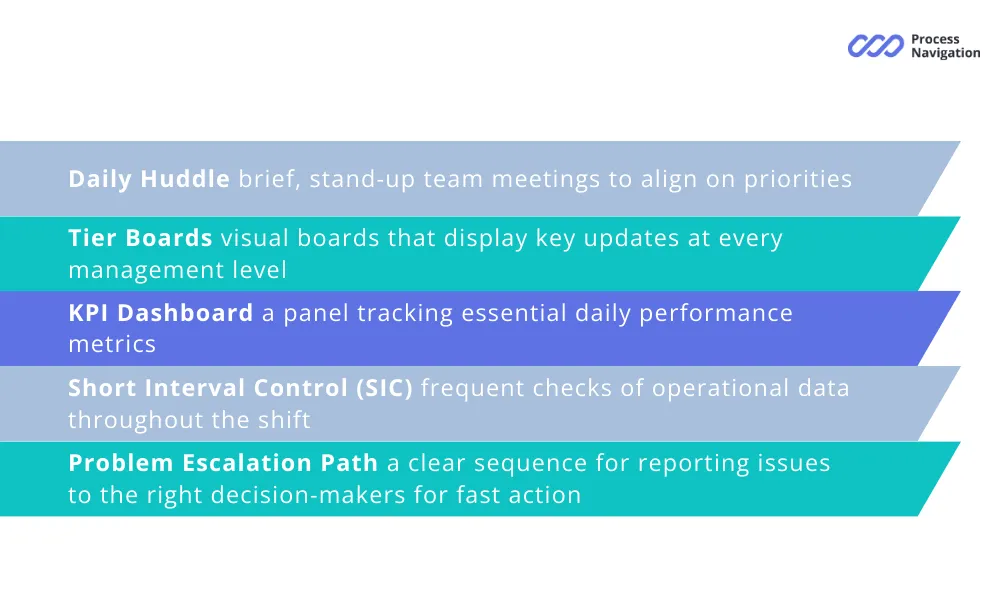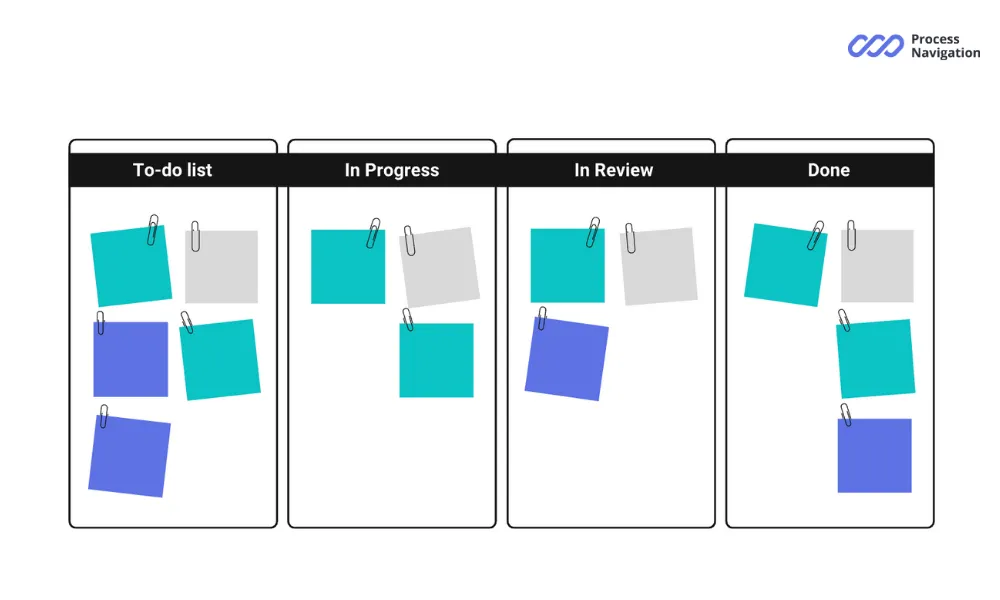In a highly competitive environment, it is important for businesses not only to achieve results, but to do so systematically and sustainably. The lean daily management system enables companies to operate flexibly and transparently, reducing waste and increasing employee engagement. It is not just a tool, but a fundamental element of a culture of continuous improvement.
A properly implemented daily management system not only supports operational consistency, but becomes the foundation of strategic alignment across departments. Daily management systems help companies address problems faster and improve visibility at all organizational levels.
Understanding Daily Management System
Daily management system (DMS) is the practice of managing day to day operations to achieve business goals. It’s about tracking key performance indicators (KPIs), setting priorities and addressing blockages through structured communication and problem solving.
A key part of a lean daily management system is the daily accountability process where employees at all levels are engaged to make sure they have the resources and support for their daily work. This process includes activities such as Leader Standard Work and Gemba Walks to check team progress, confirm to standards and identify coaching opportunities.
A well defined daily management system has clear roles, responsibilities and workflows to simplify decision making. Organizations that do daily management well experience more efficiency, less waste and higher team engagement.
The benefits include:
- Visibility: Management can see what’s happening with projects and potential risks.
- Decision Making: Leaders can make decisions with real time data.
- Collaboration: Teams work better when everyone knows what’s priority and progress.
- Performance Monitoring: Regular tracking means accountability and hitting business goals through effective management systems.
What is Lean Daily Management System
Lean daily management system (LDMS) puts lean into everyday business, eliminating waste, maximizing value and creating a culture of continuous improvement. It is is a daily management system that ensures the achievement of production and business goals through task visualization, regular stand-up meetings, and rapid response to problems.
The key elements of LDMS:

Advantages of Implementing Lean Daily Management
Introducing a daily management system brings measurable improvements across multiple business areas.
LDMS promotes active participation and accountability among team members. The system includes structured communication channels, feedback loops, and recognition programs.
The key benefits are:
| Advantage | Explanation |
| Immediate feedback | Instant response to deviations and failures |
| Increasing company productivity | By eliminating losses and inconsistencies |
| Employee involvement | People are involved in processes and feel responsible |
| Supporting a culture of continuous improvement | Continuous progress and staff development |
| Increase in product quality | Improvement in product quality |
| Competitive advantage | Increased flexibility, reduced costs |
| Goal synchronization | Due to multi-level meetings on accountability issues and meetings on the coordination of objectives |
Daily Management Boards
Before looking at examples, it’s important to understand the value of using visual tools in daily operations.
Daily management boards are visual tools to track progress, identify weaknesse and communicate. Physical (whiteboards) or digital (Kanban boards, project management software) — they give a full view of the entire production chain to resolve issues quick and prevent potential problems. Key elements of a daily management board:
- Task Prioritization: Clearly define high priority tasks to align with business objectives.
- Performance Metrics: Show KPIs for productivity, quality and efficiency.
- Issue Tracking: Show obstacles and assign to resolve.
- Continuous Improvement: Capture feedback and ideas for process change.
- Team Engagement: Get teams to interact with boards to improve flow.
- Data Analysis: Show clear charts and metrics to make decisions.
Many companies use visual management techniques to improve their daily operations and drive effective problem solving.
Lean Daily Management Board Examples
Several industries successfully utilize lean daily management boards to streamline operations. For example:
- Manufacturing: Boards monitor production targets, quality metrics, and machine downtime. Shop floor management uses the SQCDP board to visualize team performance across key metrics like Safety, Quality, Cost, Delivery, and People, facilitating development by overseeing daily tasks and progress.
- Healthcare: Visual displays highlight patient flow, staff allocation, and critical care timelines.
- IT & Software Development: Agile Kanban boards manage sprint progress, bug resolution, and deployment schedules.
- Retail: Sales monitoring, inventory management, and customer service goals are displayed to enhance operational efficiency.
- Construction: Teams rely on performance panels to monitor project milestones, subcontractor progress, and safety compliance.
A Kanban board example:

A consistent problem solving process across industries enables teams to detect the root cause of inefficiencies faster. A well-designed board enables teams to stay focused, aligned, and proactive in resolving challenges.
What Makes Daily Visual Management System Work
The table below outlines the components required to build an effective daily visual management system.
A daily visual management system helps team communication by making information visible. Here’s what’s involved:
- Key Metrics: What data points to measure.
- Format: Physical or digital tools.
- Visibility: Where to put it or use cloud based solutions.
- Frequency: Update daily.
- Engagement: Train employees to interact with it.
- Automated Reporting: Use technology for real time updates and performance tracking.
- Cross Team: Get other departments to contribute and benefit from shared insights.
- Training and Adaptation: Educating teams on effectively using and maintaining the visual system.
Organizations should integrate digital platforms, surveys, and regular check-ins to enhance engagement.
How to Implement Lean Daily Management System in Manufacturing
Use the checklist below to implement lean daily management system step-by-step.
- Analysis of current processes: Identify key control points.
- Selection of tools: Implement tier boards, SQDC boards, countermeasure trackers, and daily kaizen action lists.
- Staff training: Conduct training on short interval control, visual management, and Lean culture.
- Creating rhythm: Schedule daily huddles, stand-up meetings, and set up goal alignment huddles.
- Using data: Integrate production data into KPI boards.
- Continuous improvement: Implement the PDCA cycle and ensure visibility at all levels.
Errors and How to Avoid Them
The table below lists common mistakes and corrective actions.
| Mistake type | How to avoid |
| No visualization | Implement a visual dashboard and KPI scorecard |
| Meetings are becoming a formality | Enable analytics, daily engagement metrics, and CI insights |
| No escalation | Set up a clear problem escalation path |
| No time for RCA | Include a root cause review slot in the regulations |
| The PDCA cycle is not being followed | Use the plan-do-check-act cadence at all levels |
FAQ
Traditional meetings often focus on updates and reports. Lean Daily Management is action-oriented: it’s about visualizing the gap between the plan and actual, solving issues collaboratively, and improving processes daily.
Absolutely. Lean Daily Management doesn’t require complex infrastructure. Even a whiteboard and 15 minutes a day can make a difference — especially with digital tools like Process Navigation to support scale and consistency.
KPIs typically include quality (defects), delivery (on-time shipments), productivity (output vs. plan), and safety metrics. Visualizing them daily helps drive action.
Many business leaders turn to experienced solution providers to scale Lean systems efficiently. Process Navigation offers digital solutions that enhance daily management routines. The platform helps standardize business processes, automate escalation paths, and drive real-time collaboration using visual tools. Companies across manufacturing, logistics, and services have gained measurable improvements in company productivity and quality by adopting their system.
-
 Maintenance Plan: What Is It And How Does It Work
Maintenance Plan: What Is It And How Does It WorkIn modern manufacturing, equipment downtime costs businesses thousands of dollars an hour. The difference between...
Technology
-
 Competency Management
Competency ManagementModern businesses face a big challenge: how do you ensure every employee has the skills...
Technology
-
 Unlocking the Benefits of Total Quality Management
Unlocking the Benefits of Total Quality ManagementIn today’s competitive world, the quality of products and services is becoming the key to...
Technology
